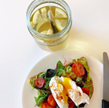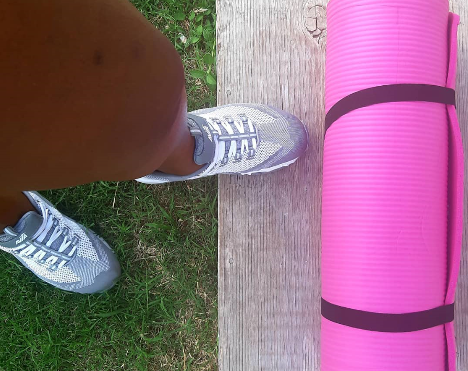Social media use has increased dramatically over the last decade, especially given its accessibility at the fingertips of all smartphone users. Instagram, a social media platform primarily for photo sharing, is the second most downloaded application in the Apple Store and connects at least 700 million users worldwide (Clement, 2020). As such, Instagram has grown to be a powerhouse in the world of staying connected; it has become a major platform for business advertising, “influencing,” and the self-promotion of its users, the majority of whom are between the ages of 18 and 34 (Clement, 2020). Despite social media’s benefits, like its ability to reach and connect millions of people all over the world, apps like Instagram have also been linked to detrimental consequences for the mental health and self-esteem of their users (Barry, Sidoti, Briggs, Reiter & Lindsey, 2017). Instagram in particular has been identified as, “the worst social media for mental health” (RSPH, 2017), and past research has found that exposure to attractive celebrities and peer images can be detrimental to women’s body image (Brown & Tiggemann, 2016).

Grace McGrew

Ciara Devereaux
Ironically, even content designed to promote positivity and well-being on the platform may potentially be associated with undesirable consequences for users. For example, “fitspiration” is a recent internet trend designed to inspire people through pictures and videos to eat healthily and to exercise with the goal of creating a fit, attractive body (Holland & Tiggemann, 2017; Tiggemann & Zaccardo, 2016). The goal of Instagram fitspiration content is to inspire followers and motivate them to hit the gym and better themselves, both physically and mentally. However, many fitspiration posts include photos of bodies without faces or heads, or posing in a sexual manner (Santarossa, Coyne, Lisinski, & Woodruff, 2019), which, research suggests, may be associated with body image and self-esteem issues among followers (Brown & Tiggemann, 2016).
Social media connects millions of people worldwide, including both of us. We have been followers of fitspiration for several years, and were curious about the long-term effects that it may have on our peers’ and our own mental health, as this topic has not been thoroughly researched before. We were awarded a Summer Undergraduate Research Fellowship to conduct research on fitspiration over the course of ten weeks in the summer of 2020. Both of us have worked with Dr. Jolie Wormwood for the past three years at the University of New Hampshire (UNH), so we wanted to collaborate with her on this research, as well as with one of the graduate students in her lab. Our goals were to gain a greater understanding of how users perceive different types of fitspiration posts, and how exposure to these different types of fitspiration content are associated with changes in users’ mental health. This project allowed us to gain hands-on experience conducting research on how social media impacts the well-being of those viewing it. Learning about mental health is extremely important to us both from a career perspective as well, as we both hope to go into the medical field: Ciara into psychiatry and Grace into sports medicine. Conducting this research gave us a new perspective on mental health and the consequences that can come from social media usage.
We feel that many readers may have limited information on the effects that Instagram and fitness-based accounts have on mental health. In particular, they may be under the impression that fitspiration is solely a helpful motivator for working out or eating healthily, and they may be unaware of potential unintended negative consequences of following such content on social media. Fitspiration users may have unrealistic body standards from fitspiration exposure, which could lead to worse body satisfaction and lower self-esteem. Through our research, we sought to shed light on these misconceptions that many users may have and not be aware of and to gain a better understanding of the effects fitspiration content can have on its users.
Study Design
We conducted our research through two distinct studies. For the first study, we gathered data on how women perceive the various kinds of fitspiration content they see. Specifically, we examined how followers of fitspiration influencers and hashtags categorized actual fitspiration content drawn from Instagram. For the second study, we used a daily diary framework to gather information on women’s day-to-day Instagram usage, the content they saw, and their self-esteem and mental health symptoms. Both studies were created using the survey platform Qualtrics and distributed to participants using Amazon’s Mechanical Turk, an online survey distribution platform which uses crowdsourcing of pre-established users to find participants. Participants were women between the ages of 23 and 60 from the United States who followed fitspiration content. For the first study we had twenty-three participants, and for the second we had forty-eight participants.
Methods for Study 1
We originally intended to pull public Instagram images using an automated online software program, Netlytics (2006). However, when we tried to implement our search in Netlytics, we found out that the program did not work for our needs, due to recent updates to Instagram and Facebook. Instead, we had to create a much more labor-intensive method to pull public Instagram images for use in the study, which involved manually searching via specific hashtags (#fitspiration, #fitspo, #wellness, and #healthylifestyle). We downloaded and catalogued one hundred images from social media each day for five days, for a total of five hundred photos. Each day’s set of one hundred images included twenty-five photos from each of the four hashtags.

After photo collection, we removed images unrelated to fitspiration and duplicate images, leaving us with 229 photos that we reviewed and coded for image content. Based on this coding, we narrowed the 229 photos down to 30 images for use in our study, with 6 photos representing each of 5 content categories identified in previous research on fitspiration content (Santarossa et al., 2016; Tiggemann & Zaccardo, 2018): selfie, food/supplement, action, objectification, and other. We categorized photos as selfies if they involved a photo the subject had taken of themselves without assistance; food/supplement photos included images of food or of, for example, a protein powder or healthy vitamin; action photos were of someone engaging in the action of working out or other physical activity; objectification photos included images in which only the individual’s body (and not their face) was featured or in which the subject was posing in a sexualized manner; and the “other” category consisted of images that did not fit into the other categories, such as a motivational quote, a picture of the gym, or a piece of workout equipment. These five image categories were for our reference for data analysis; participants were not told the five image categories.

In the first study, we asked participants to come up with their own categories for the fitspiration posts based on how the
posts made them feel while viewing them, rather than in terms of the content itself. Participants could create as many categories as they liked, and we asked them to provide emotion labels for each category they created, such that the labels described how the content in that category made them feel. We coded the emotion labels generated by participants and looked at how these labels were associated with the five types of content (selfie, food/supplements, etc.), as well as with individual differences, such as participants’ self-reported self-worth and body satisfaction. As part of this coding, we placed the participants’ emotion labels into three affect categories: positive affect, neutral affect, or negative affect. We then further sorted participants’ labels into several affect sub-categories: negative annoyed (e.g., “uninspired,” “judgmental”); negative comparative (e.g., “makes me feel pressured,” “inadequate”); neutral (e.g., “bored,” “fatigued”); neutral hungry (e.g., “hungry”); positive motivated (e.g., “inspired,” “encouraged”); positive healthy (e.g., “strong,” “nutritious”); and positive other (e.g., “proud,” “attractive”).

Figure 1: These images demonstrate examples of the image’s participants were shown and asked to categorize based on how they felt in Study 1. The image of the meal is an example of a “food/supplement,” the quote falls into the “other” category, and the yoga mat is "action."
Results for Study 1: Emotional Response to Fitspiration Categories
In the first study, we found that the majority of fitspiration images elicited positive affect (56 percent), and the majority of positive emotion labels indicated the intended effect of fitspiration content: feelings of positivity and motivation/inspiration (92 percent). For example, participants provided category labels like, “This is a motivational group, the words and pictures make me feel more dedicated to my goals,” or “Inspires me to lose weight.” Interestingly, few fitspiration images were sorted into piles indicating more neutral feelings (16 percent), suggesting people generally find the images evocative if not necessarily all positive or all negative.
Critically, the affect elicited by fitspiration images differed across more specific content types. We found that action, food, and the “other” category of fitspiration content may more generally be associated with positive affect (compared to negative affect), while selfies, before-and-after, and suggestive pose content appear to have a more polarizing impact on people’s feelings, with individuals associating these images with positive and negative affect with approximately equal likelihood. For example, one participant perceived a selfie image made them feel, “pressured into looking or feeling or acting a certain way,” while another described her feelings as, “inspired and hopeful.”
Furthermore, analyses also revealed that affective reactions to fitspiration photos varied across individuals based on their level of body satisfaction: the more satisfied participants were with their body, the more likely they were to place fitspiration images overall in negative affect categories, particularly fitspiration images containing selfies, before-and-after photos, and images with suggestive poses. This result was definitely surprising, because we wouldn’t expect someone with a higher body satisfaction to categorize fitspiration posts negatively overall, and we are unsure as to why that trend occurred. One possibility could be that people who are already satisfied with their bodies find posts encouraging them to work out or eat healthily annoying because they don’t want advice about changing a body with which they are satisfied. Another possibility is that people may feel the posts encourage others to be dissatisfied with their bodies, which is an area that future research could explore.
Methods for Study 2
In the second study, we again recruited participants through Amazon’s Mechanical Turk and surveyed them each day over the course of a week about their daily Instagram usage. The surveys consisted of fill-in-the-blank questions related to Instagram usage and multiple-choice questions that asked participants to rate their feelings on a series of scales to survey their daily self-esteem, perceived social comparison to peers, and depression symptomology. Participants also reported each day on whether specific types of fitspiration content viewed impacted their motivation to eat healthily and/or engage in physical activity/exercise that day. The primary objective of the second study was to gather critical new insights about whether changes in users’ self-reported feelings about themselves and their mental health symptoms were associated with changes in the proportion or types of fitspiration images they viewed throughout their daily lives.
Results for Study 2: Daily Fitspiration Use and Its Effects
We found that viewing food-related fitspiration images was associated with greater motivation to eat healthily. Similarly, we found that viewing workout-related fitspiration images was associated with greater motivation to go to the gym. These two findings suggest that daily exposure to fitspiration content on Instagram may have some desired impacts. However, findings also revealed that certain kinds of fitspiration content may have unintended negative consequences for well-being. For example, individuals reported significantly lower self-esteem on days when they were exposed to more before-and-after fitspiration images or sexually suggestive fitspiration images. Individuals also reported significantly more negative social comparisons to others on days when they were exposed to more food-related fitspiration images.
Final Thoughts: How Can We Better Understand Fitspiration’s Effects?
From our research, we found that many previous studies that looked at fitspiration as a single, broad category of online content seemed to miss important aspects of the different types of fitspiration content. Our first study demonstrated that some types of fitspiration content have an overall negative effect on feelings, whereas other types of content have an overall positive effect on feelings. This was replicated in our second study, where we saw differences in how daily exposure to fitspiration content was associated with self-esteem and well-being, depending on the specific kind of fitspiration content viewed that day.
Furthermore, we also saw that even the same types of content can impact different individuals in different ways. For example, results from the first study revealed that the more satisfied participants were with their bodies, the more likely they were to indicate negative feelings when viewing fitspiration images overall, particularly fitspiration images containing selfies, before-and-after photos, and images with suggestive poses.
Overall, our research is significant, because it examines how fitspiration includes a variety of types of images, rather than one broad category, and how it impacts different people in different ways. Our research helps to shed new light on the potential negative effects that Instagram usage, particularly the consumption of Instagram fitspiration content, can have on individuals. There is still much we do not know about the ways in which social media usage may influence mental health and well-being, but our research has laid a crucial foundation for future research in this area.
The data we collected could be used to develop methods to reduce the negative impacts that social media apps, such as Instagram, have on well-being, and to help users find healthier ways to engage with social media in their daily lives. For instance, this research could help determine better ways to motivate social media users to live a healthy lifestyle by encouraging users to go to the gym or eat healthily, without causing them to sacrifice their self-esteem or positive body image, or to feel bad in comparison to other lifestyles that people are leading. In future work on this topic, further individual difference variables should be examined, such as whether someone is overweight or underweight.
On a personal level, this research experience greatly expanded our critical thinking skills. Collaborating with researchers on this cutting-edge psychological science project also further advanced our leadership and teamwork skills. This experience added to our understanding of mental health, which is such an important part of everyday life. Poorer mental health is associated with changes in one's behavior, emotions, and thinking, all of which can contribute adversely to one’s social life and overall well-being. We hope that the knowledge we have shared about the types of content that make users feel good about themselves (versus bad about themselves) will promote a change in the fitspiration content posted by those who truly intend to motivate and inspire their followers to be well. We also hope that this research will enable our community to better understand the consequences, both good and bad, of consuming fitness-based social media.
We would like to thank our mentor, Dr. Jolie Wormwood, and Abby LaChance for helping us through the process of completing this research. We would also like to thank the Hamel Center for Undergraduate Research staff and Mr. Dana Hamel, as without them this research could not have been completed. We are extremely grateful for the opportunity to complete this project and for those who helped us along the way.
References
Barry, C. T., Sidoti, C. L., Briggs, S. M., Reiter, S. R., & Lindsey, R. A. (2017). Adolescent social media use and mental health from adolescent and parent perspectives. Journal of Adolescence, 61, 1–11. https://doi.org/10.1016/j.adolescence.2017.08.005
Brown, Z., & Tiggemann, M. (2016). Attractive celebrity and peer images on Instagram: Effect on womens mood and body image. Body Image, 19, 37–43. https://doi.org/10.1016/j.bodyim.2016.08.007
Clement, J. (2020). Global Instagram user age & gender distribution 2020. Retrieved [2020] from http://www.statista.com/statistics/248769/age-distribution-of-worldwide-....
Holland G, & Tiggemann M. "Strong beats skinny every time": Disordered eating and compulsive exercise in women who post fitspiration on Instagram. The International journal of eating disorders, 50(1), 76–79. https://doi.org/10.1002/eat.22559
Royal Society for Public Health [RSPH]. (2017). Instagram ranked worst for young people's mental health. Retrieved [2020] from https://www.rsph.org.uk/about-us/news/instagram-ranked-worst-for-young-people-s-mental-health.html
Santarossa, S., Coyne, P., Lisinski, C., & Woodruff, S. J. (2016). #fitspo on Instagram: A mixed methods approach using Netlytic and photo analysis, uncovering the online discussion and author/image characteristics. Journal of Health Psychology, 24(3), 376–385. https://doi.org/10.1177/1359105316676334
“Social Media Text and Social Networks Analyzer.” NETLYTIC, 2006, netlytic.org/.
Tiggemann, M., & Zaccardo, M. (2016). ‘Strong is the new skinny’: A content analysis of #fitspiration images on Instagram. Journal of Health Psychology, 23(8), 1003–1011. https://doi.org/10.1177/1359105316639436
Author and Mentor Bios
Ciara Devereaux, a biology major from Woburn, Massachusetts, will graduate in spring 2021 from the University of New Hampshire (UNH). She conducted her research as part of the Summer Undergraduate Research Fellowship (SURF) program. She and her coauthor, Grace, have been followers of fitspiration and wanted to explore the larger implications of its negative consequences. This project allowed Ciara to learn more about how to conduct a research study independently, which broadened her quantitative and analytical skills. One challenging aspect was completing their project remotely due to the COVID-19 pandemic. Ciara says that the most rewarding part of the experience was seeing the results come together at the end and knowing that their research might be used for a greater purpose. She believes that Inquiry is a great way to relay information and teach social media users about the potential effects that fitspiration may have on mental health. After graduating from UNH, Ciara plans to attend medical school and become a doctor. She says that her future in medicine will be greatly benefitted by her research, which helped her gain confidence in her academic abilities, and allowed her to collaborate with others on cutting-edge psychological research that further advanced her leadership and teamwork abilities.
Grace McGrew, from Lake Placid, New York, is a senior at the University of New Hampshire (UNH). She is in the University Honors Program with a major in neuroscience and behavior and a minor in French. Her research was conducted as part of the Summer Undergraduate Research Fellowship (SURF) program. She and her coauthor, Ciara, follow fitspiration content and noticed a lack of research into its effects on mental health, so they decided to explore this topic in more detail. Grace learned about the broad scope of subjects and images that fitspiration encompasses, and she also gained a better understanding of how to conduct independent research. The biggest challenge that Grace and Ciara faced was completing their project remotely due to the pandemic. Grace says that the most satisfactory part of the project was putting together their findings and seeing that their work had led to significant data. She is excited to share her findings with the Inquiry audience, especially since many college students are impacted by fitspiration. Grace’s career goal is to attend medical school and go into sports medicine. She says that this project has helped her to better understand how certain factors, such as social media use, impact mental health. By writing for Inquiry Grace has become more confident in her scientific writing abilities, which she is sure will help her throughout her career.
Jolie B. Wormwood, assistant professor in the psychology department at the University of New Hampshire (UNH), mentored Ciara and Grace during their research process. Dr. Wormwood has worked at UNH since the fall of 2018 and conducts research related to how affect and emotion guide social perception and decision making, with a particular focus on experience and behavior in stressful or threatening contexts. Ciara and Grace had both been working as undergraduate research assistants in her lab, the Affect and Social Psychophysiology (ASP) Lab, for a few years and approached her about applying for a Summer Undergraduate Research Fellowship (SURF) award to pursue research on the impacts of social media on affect and well-being. This was Dr. Wormwood’s first time mentoring a SURF project and, subsequently, Inquiry authors; she says it was fun to work with Ciara and Grace to see their research ideas come to fruition. They hope to submit a manuscript on their findings to a peer-reviewed journal later this year. Dr. Wormwood is thankful for the Hamel Center for Undergraduate Research and Mr. Dana Hamel for making research opportunities like this available to undergraduate students at UNH.
Copyright 2021, Ciara Devereaux and Grace McGrew
